 |
 |
3 X 3: New Media Fix(es) on Turbulence
|
 |
 |
 the body in turbulence the body in turbulence |
 |
 |
 il corpo in “turbulence” il corpo in “turbulence” |
 |
 el cuerpo en turbulencia el cuerpo en turbulencia |
 |
| by Josephine Bosma | Edited by Jo-Anne Green, Helen Thorington |
 |
 |
 |
Ten years of Turbulence. It sounds like a disaster. This is ten years of carefully constructed turbulence however… ten years of patiently supporting, building and collecting online art. One striking thing about turbulence.org is the contrast between its name and its content. Turbulence.org is calm and balanced. I have watched it develop slowly, and wondered where it would go. In the beginning it was very much a labor of love: my guess is that much of it still is. One can sense Helen Thorington’s personal touch in the background. Helen Thorington is an important representative of radio art, sound art and performance art in the United States. She founded the influential series for radio and sound art, New American Radio (1), in 1987 and started turbulence.org for a more in-depth focus on net art in 1996. Three years ago she was joined by Jo-Anne Green. What has always drawn me most to Turbulence is its special focus on sound art and performance art. Turbulence has always looked beyond the screen.
|
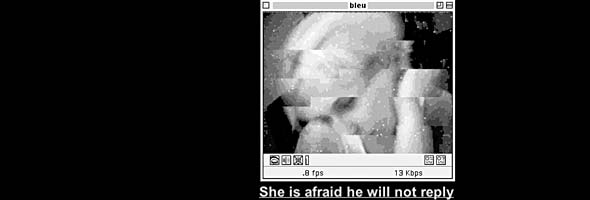
Tina la Porta | Distance | 1999
|
 |
| performance and media |
 |
  perfomance e media perfomance e media |
 |
  performance y medios performance y medios |
 |
It is a myth that online art or net art is about leaving the physical world behind or de-materializing
art. For as long as it has existed net art has been very much about connecting spaces and bodies, about building bridges and establishing interpersonal connections. Think of the 1980 Hole in Space installation Public Communication Sculpture by Sherrie Rabinowitz and Kit Galloway (2), and also of the multimedia performances using a forerunner of the Internet in the early eighties (3). A little later, around 1990, decentralized musical performances using the early Internet developed, and online performance was to culminate in the as yet unequalled live network extravaganza of Van Gogh TV at Documenta 9 in 1992 (4). Performance is the basic art of the Internet. But what is performance art? In the 60s and 70s of the twentieth century, performance art was about witnessing live actions, seemingly unique, that performed the artist’s genius in real time. Performance art however started to repeat itself, re-enact itself, and in doing so it often became like theatre. Performance art also became mediated, performed in video or radio. Stretched in time in art installations or multimedia settings its performative quality slowed down to the pace of life itself.
Repeatable. Mediated. Individual time. The web offers a manifold of works and sites that all offer on demand re-accessible content. The web is a mostly shapeless and chaotic medium: it holds massive amounts of material for us to edit into our very own experience. Its individual cut is created by our very own clicks. But the Internet as a whole is also very much about communication and connecting, and as such has performance and process among its core qualities. In this environment performance art, art focusing on bodily presence and movement, offers an encounter with ourselves in a different way. Performance art online is about the frailty of the new human body (comparable to Pierre Levy’s “hyperbody” (5) or Catherine Hayles’ Posthuman (6), its loneliness and the construction of identity or reality. It lacks the smell and physical nearness of a performance in real life, but it reminds us of the physical and social basic state we left behind on entering the network. In doing so it can be just as dramatically powerful, annoying or confronting as its physical counterpart. It can be like not simply watching a movie but being right there in the scenes. Online performance uses our presence, our bodies, to become real.
|
| the new body in net art |
 |
  il nuovo corpo nella net art il nuovo corpo nella net art |
 |
|
 |
Our bodies have been changed by their relatively new connectedness to media. The personal computer and the mobile phone have radically altered our personal spaces. While our social lives become more active and diverse, our bodies become more immobile and passive. We sit and touch the keys, at our desks, in the park, on the train, at the airport. Our social activity and bodily movement do not match. This is the state of the new body: socially hyperactive and physically displaced. We often are not where we are. Both social hyperactivity and physical displacement have been themes in net art for a long time. The interesting thing about both is that at the same time they remove us from our body and make us aware of it. There is an uncertainty there, a loss of balance, which can be both stimulating and paralyzing.
Forerunners of net art, or very early examples of it, were all about mediated communication ecstasy. The new body had not really become the dominant social and cultural phenomenon it is today, because the technology that created it was still difficult to access (digital networks) or had not developed much at all (mobile phones). Experiments in art with new media were necessarily about group activity in those early days, but the choice of media already defined the user experience. Two early works illustrate the transition from old to new body.
When Sherrie Rabinowitz and Kit Galloway did their Hole in Space the audience and/or participants’
experience was very different from that of The World in 24 Hours initiated by Robert Adrian (7). The difference was caused by the technology: the first used a simple live TV satellite link, the second was based on a cacophony of fax, slow scan TV, email and radio. The very direct and simple interaction in Hole in Space, waving and yelling at people thousands of miles away while they wave and yell back at you, leaves our physical presence intact. There is no doubt about where you are as an audience, there is just the marvel of the magic mirror that opens up space and time, but which does not swallow us up. There is a sense of intimacy, with the audience around, with the people at the other side, based on group consciousness and physical closeness.
The World in 24 Hours on the other hand was not only a decentralized performance between locations, but it was also in some sense “decentralized” at every location. Participants in this performance were sitting at terminals, waiting and sending at fax machines, or taking and watching pictures. They were divided by the characteristics of the technology they applied. Even if they were more of a group then the coincidental audience in Hole in Space because they were collaborators rather then participants, their sense of the performance was very much defined by their individual actions and roles at each location. These collaborators had to communicate extensively locally and medially in order to experience the piece fully, and in order to actually accomplish the work at all. They must have experienced a physical group consciousness and a feeling of dislocation at the same time.
Newer online performances are dealing with a different type of network altogether. The basic principles of connected computers, servers, cables and satellites are still there, but new technologies (F.Ex. the web, peer to peer software) have been layered on top of them. Not only that: since The World in 24 Hours computers and Internet access have become personal media. We don’t go to an institution for network or computer access, we have access in our homes or we carry it around in our pockets. This has provoked the development of the new body, or something very close to it. We are nearing the physical experience described in E.M. Forster’s The Machine Stops (8) written in 1909: immobility and isolation combined with a totally mediated life. As our world becomes physically smaller than it is socially, memories of movement and physicality start to creep up on us, perhaps even haunt us. This is why online performance, even if it is obviously not live, is so compelling.
|
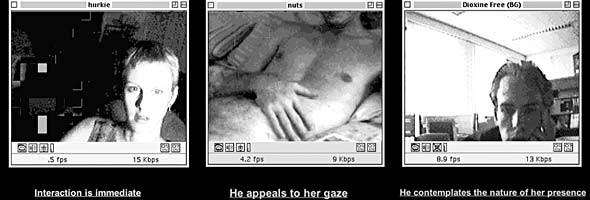
Tina la Porta | Distance | 1999
|
 |
Tina LaPorta - Distance
In the Turbulence database we find works that offer the chance to contemplate the development of online performance and the new body. We start by looking at Tina LaPorta’s Distance from 1999 (9). This work looks like a reflection of the experience of meeting people through CUseeme software, video conferencing software that was developed in 199 . Making use of a webcam, it allowed people to see each other through while chatting one on one or in groups. The simple black and white pictures of CUseeme had a special magic. As in many net art works, especially in early web art, this magic is partly caused by the absence of sound, and in this case, the absence of color. Net art was a bit of a shock to the audience that, like many young artists, went online in the mid nineties. In fact the web created the first real audience online. Before the web “being online” meant taking part in all kinds of intimate, interpersonal exchanges, not surfing through web pages. This is why the latter is sometimes mockingly called interpassivity. This new, more passive online audience had been spoiled with loud Technicolor movies and color TV. A screen that showed only text and some simple images felt like a downgrade of media aesthetics. Robbed of sound, fluent movement and in cases like Distance even of color – this seemingly “amputated” screen was the environment of a new social and cultural interaction, in which both the technology and its ‘users’, the audience, were under development. Distance shows the vulnerability of both. The absence of sound makes the audience aware of itself. It creates a bubble around viewer and screen, a special connection between the two. Moving image without sound, even the movement created by a mouse click, often feels unnatural.
Is this work merely a reflection of CUseeme, that is, mostly formal? I would not say so. This is a work of art created for a specific environment to reflect and comment on universal questions about human existence in that environment. It is a moving, sad piece, dealing more with emotions than with technology. Like a black and white movie from the 1920s it will stay powerful, even if dated, for a long time. Art works are always retraceable to their time. There is nothing wrong with that.
Distance is a harsh work, painful to watch. It is painful to watch because of its combination of
simple technological gestures, almost predictable but essential artistic choices, and the display of obvious human failure and desire to establish substantial contacts with others. It is a simple reflection of mediated loneliness, and as such is reminiscent of the work of, for instance, Canadian movie director Atom Egoyan (10) for whom social interaction via the lens of a camera and intermediated loneliness is a recurrent theme. The sequence of images in Distance forms a slow movie in which we automatically fill the gaps between the images with our imagination. The pain we feel is the embarrassment of being confronted with another person’s pain, but also melancholic sympathy and recognition. It reminds me very much of how some “traditional”, physical performances make me feel: you want to walk away and keep watching at the same time. Even if the people in the images are not naked, it almost feels as if they are.
LaPorta’s choice of images (CUseeme windows showing photos of participants) and words at the same time creates the illusion of participation and a sense of loneliness. LaPorta makes an interesting comment about displacement in an interview with David Rieder that can be found at the Turbulence site. She sees another kind of displacement besides the loss of balance between our social interactions and physical movements. To LaPorta our access to cyberspace creates a strange double bind of being public while still being locked or hidden in the privacy of a personal space. We are “always [..] just outside of it, unable or unwilling to immerse [ourselves] completely in the space of the public.” (11) Being online makes media persona out of each and every one of us, at least in part.
|
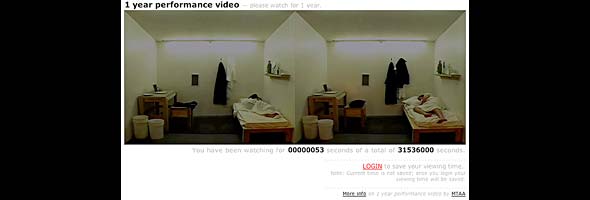
MTAA | 1 Year Performance Video (aka samHsiehUpdate) | 2004 |
 |
MTAA – 1 Year Performance Video (aka samHsiehUpdate)
If we compare this work to another project at Turbulence, MTAA’s 1 Year Performance Video (12), the contrast in emotional appeal of the work is enormous. MTAA’s work is the translation of an emotionally powerful work, Sam Hsieh’s performance in which he locked himself in his studio for a year in 1978 (13), into a technological solution of this idea which frees the artists from having to endure Hsieh’s confinement. They (M.River and T.Whid) connected some videos of themselves to a software application that cleverly manages to give the illusion of a live webcast of the artists locked in their studios. There is no attempt to conceal the technical tricks in this re-enactment; instead they are emphasized in a statement. This emphasis makes the emotional or engaging part of this work disappear almost entirely. 1 Year Performance Video is said to be part of a tradition or trend of re-enactment of older art works. In the environment of the web however it also becomes part of the world of games. This is an art game, and in this case there is even a prize: the work itself once the viewer has managed to run it for a year. There is a list of best players. The audience is captured through technological “challenges”. It would seem the audience is challenged to become like the artist in Sam Hsieh’s performance: locked not in a box, but to a box this time. There is the illusion of physical endurance, when in fact the audience only has to do what the artists did: make the machine do the work for them. The only challenge in this game is really not to forget to turn it on every time you go online.
There is an obvious connection to the playful and provocative side of net art in this work. The artists’ statement that with present day technology an artist can let a machine do the work is clearly dripping with irony and provocation. Many critics have discarded net art because it allegedly only copies or mimics older art disciplines and adds nothing new to art discourse. MTAA cynically give these critics what they want to see in net art, and throw it back at them in their own language. They seem to be giving them the finger. “We no longer need original ideas; we just need to improve the old ones” (14). It reminds me of a statement by the Italian group 0100101110101101.org made in an interview with Tilman Baumgaertel for the online magazine Telepolis in 1999 (15). In a discussion about controversial art interventions, such as Alexander Brener’s spraying paint over a Malevich painting in the Amsterdam National Museum of Modern Art (Stedelijk Museum), Baumgaertel asked whether this did not make it impossible for people to see the Malevich. The artists replied: “Well, they can look at it in catalogues”. (16) Provocation does not create the most thoughtful kind of discourse, but it does create your own space, affirming your position. It forces others around you to take positions too.
This work is the emotional opposite of Distance by LaPorta. Instead of lamenting the loss of reality and real intimacy this loss is celebrated and radically implemented into the work. 1 Year Performance Video does not confront us with the frailty of our body and of reality online (the artists assume we have already been aware of that for a long time), but it helps us get over it and accept it, in a humorous, empowering way.
|
|
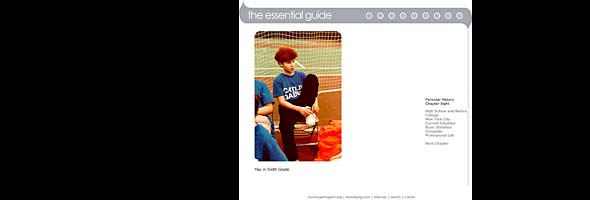
Michael Mandiberg | The Essential Guide to Performing Michael Mandiberg | 2002
|
 |
Michael Mandiberg - The Essential Guide to Performing Michael Mandiberg
The Essential Guide to Performing Michael Mandiberg (17) is of a very different nature again. This
work was made for a larger project initiated by Mandiberg in which artists were to swap identities (18). The artist wrote a kind of manual in which he explains himself in great detail. Almost everything from his psychological profile to his friends to his childhood to his school career to his favorite food and music is there. The work is a strange combination of exhibitionism and distancing. The choice of relevant facts to perform Michael Mandiberg would however probably look a lot different if someone close to him had written this guide. Some substantial things are missing: his first kiss, his credit card number, his political convictions, his hopes and fears for the future. In fact, it might look like a substantial description of the artist at first glance, but when taking a closer look, the guide offers a limited view of Mandiberg, one that from an amused female point of view like mine seems typically male. A sentence in the guide that shows the tension between exhibitionism and distancing I found especially funny was the comment in the chapter on “self confidence” which says: “In the past your self confidence devolved into arrogance, though now it is not directed at others, but is circulated inside yourself.”
Using the word “you” instead of “I”, and “your” instead of “mine”, throughout the entire guide not only distances the artist from himself (and somehow removes him from the text) and creates the illusion of objectivity, it also lifts the self-perception of Michael Mandiberg onto a plane of universal truths. In all his apparent vulnerability the artist is really untouchable. The choice of this semi-objective language and writing a biography shaped as a ‘how-to’ guide however also flattens the “user” experience of what is, in essence, an emotional work. The guide is almost devoid of emotion, or rather, emotion is suppressed and deformed. This serves a purpose, that of performing a conceptual art score, something I will address later.
The guide places a lot of emphasis on Mandiberg as an artist. The chapters that describe what he likes and does not like almost only discuss art, for instance. The piece sometimes reads more like advertising than biography. The artist has deconstructed himself into bits of information that cover only that specific part of him he wants to present. He does make some courageous choices at times, like when he presents his bisexuality and reveals that he likes to use a buttplug when masturbating. In an interview with Eryk Salvaggio, Mandiberg says he tries to sell himself as if he were made up of objects, like he once sold items from his life in Shop Mandiberg (19). Somehow I can’t escape the feeling that there is more dirty laundry and sensitive items missing in this “shop” or guide than there were missing from the previous project ‘Shop Mandiberg’. A guide to perform another human being through and through should contain much more personal, positive and negative information, at least, that is the potential and maybe also pretence of this work. The text loses strength and does not live up to its radical potential because it does not contain that dirty data.
The text might not perform on a radically intimate level, but it still performs very well as an introduction. Meeting someone online has never been so well prepared and thorough. Mandiberg has recreated himself as a fictional character. The Essential Guide to Performing Michael Mandiberg is probably one of the most extensive conceptual art scores ever written, if we read it as such. It hovers somewhere between a film script, a biography and an art score. The right actor or performer could therefore put the radical potential missing from the text back into it. What the text lacks in strength as guide alone, it gains in strength from the context of the identity swap it was originally written for. Just as famous conceptual art scores have been performed very differently by individual artists over the years, this guide could produce very different versions of Michael Mandiberg (20).
In the context of the web the work also asks questions about privacy and identity. It would seem as if the artist tries to stay ahead of attempts at interpretations of himself as a media persona. His selective and purified presentation of himself could be seen as an attempt to regain control of his life after his unexpected success with Shop Mandiberg and the attention overload that came with it. In his next work at Turbulence Mandiberg seems to have come to terms with his exposure completely. In IN Network Mandiberg and his partner Julia Steinmetz use genuine personal media fragments. Even if there was a selection process at the basis of IN Network, it does not affect its strength.
|
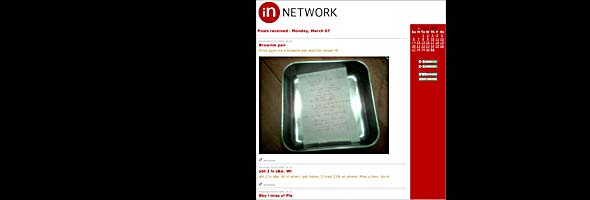
Michael Mandiberg and Julia Steinmetz | IN Network | 2005
|
 |
Michael Mandiberg and Julia Steinmetz - IN Network
Two people, thousands of miles apart, living together through cell phones. They don’t just call each other a few times a day, but actually eat together, sleep together, and travel together over the phone. They might not be on the phone with each other 24 hours a day, but they have found a way to be as intimate as possible through a cell phone a lot of the time. They tenderly call each other “dude”, they do not hide their affection, they fall silent sometimes and they discuss private matters. They send each other pictures and highly simplified text messages. Live on Turbulence for one month, the phone calls, messages and pictures of their lives are now collected to form IN Network, an online archive of performance, documentary and blog (21).
IN Network uses the format of the blog (weblog). Blogging is an immensely popular version of the online diary. It is used for all sorts of purposes, from locals reporting about the situation in Baghdad to proud parents showing baby pictures. The strongest quality of the blog software is that it is so easy to use that working with it is a bit like sketching or writing on paper: the hand of the maker (blogger, artist, writer) has a very direct impact on the result. This is potentially very expressive software for websites. Still it takes talent, insight and ideas to make it work, to create something special with “blogware”, just as it does with ink and paper. IN Network shows what artists can do with blogging. It shows that it is not the software, but the person who applies it that makes the difference in the end. The selection of recordings, photos and texts, the consistency and disarming tenderness of their content, and the way the artists used the compactness of the blog format have produced an immensely powerful document. It has a very strong documentary or movie feel. There are the scenes (expressed in sound files, texts and photographs spread over and within the days of a month), the reality of the subjects, and the editing.
The latter is of course controlled and executed by the viewer, but the very strong sentiment behind the work will always dominate her experience, no matter how she “edits” or clicks her way through the work. It gives this work a very strong immersive potential or quality. IN Network confronts the audience with the closeness of lovers, lovers who are actually not much closer to each other physically then the audience is to them.
|
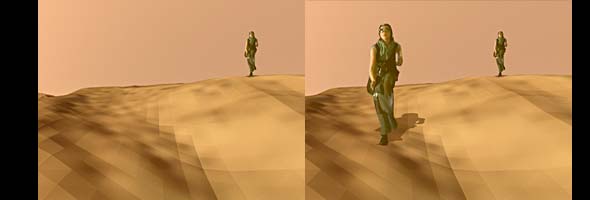
Yael Kanarek | World of Awe | 2003
|
 |
Yael Kanarek with Evan Siebens and Yoav Gal et.al – World of Awe: Portal
Representing dance in media is always difficult. Portal is dance made specifically for the web (22).
In the case of Portal the artist has chosen to let the online environment (the internet, the software and the audience) be part of the dance in a structural way. The result is an interactive dance movie consisting of three parts, each with a slightly different feel. The movies are made in flash, popular software for commercial web sites because it allows the designer to create smooth moving images and sound, which are hard to escape for the audience. They have especially strong sound tracks by Yoav Gal.
The films are supposed to serve as portals to Kanarek’s long running project World of Awe (23), yet they are also strong on their own. World of Awe is a kind of fairytale world invented by the artist, which can be entered through imaginary portals. These entrances to a parallel universe are explored and opened by the dancer, called “the traveler” in the words of Kanarek. The dancer is a young woman, dressed in a hood and pilot goggles in the first and last dance, and vulnerably naked in the middle one. The dancer represents our passing through the portal. She seems a bit like the ferryman on the river Styx, destined to spend eternity in those portals, dancing and gesturing to the enchanting music. If the previous examples remind us most of all of the immaterial side of our bodies, our distance from our bodies in cyberspace and the distortion or change of our immaterial selves through media, the experience of watching a dancer is a much more direct reminder of our bodies themselves. Here is a body that moves to our mouse click, which repeats gestures and can be put into an embarrassing position if we choose, the naked figure most of all. We become the dancer and the manipulator at the same time.
Manipulating a human figure is a familiar characteristic of the world of games. Most of these figures have a rather limited set of possible movements and gestures. The possibilities for manipulating the dancer in Portal are limited as well. We can only instigate small changes, but their impact is quite powerful. Creating a repetition of movement or an echo of movement already gives us a lot more power then dance audiences generally have. It makes us part of the performance, as we are drawn into the piece not just by our interactions with it, but also through our identification with the human figure that is forced to repeat its movements over and over. This is a double engagement, emotionally enhanced by the repetitive and ethereal music.
World of Awe, the project Portal is a part of and reminds us a little bit of another long running artist’s universe online: mouchette.org (24). Both World of Awe and Mouchette are created by women (the artist behind mouchette.org however chooses to stay anonymous). Both have developed over a period of ten years now, in which they have created many sub-projects inside their “worlds”. In Mouchette the alternative universe is that of a fictional young girl who wants to commit suicide, whereas World of Awe deals with a fictional “traveler” between reality and the World of Awe. Both sites approach the audience in a very emotional way. In Mouchette the audience is struck and captured by the powerful, emotional combination of children and death. In World of Awe it is the dreamlike projection of a parallel universe of love behind the chaos and cold of a big city (New York) that appeals to the imagination. We enter these worlds as we would enter a dream. Both projects contain beauty and darkness, dream and nightmare, overlapping each other. Both also reach out to the audience at a quite intimate level. Mouchette sends personalized emails to members of the audience who leave their addresses on the site, and so does World of Awe. Mouchette however shows more traces of the audience inside the work itself, carefully placed, thereby making the work even more attractive and open. Both sites are very immersive and emotionally complex. Instead of pulling the audience in slide by slide, like Distance does, they offer, like IN Network (with its sound fragments), 1 Year Performance Video and also David Crawford’s Stop Motion Studies, the chance to be momentarily relieved of the online habit of being the surfer. They offer the chance to become mesmerized, to pause, contemplate or gaze.
|
|
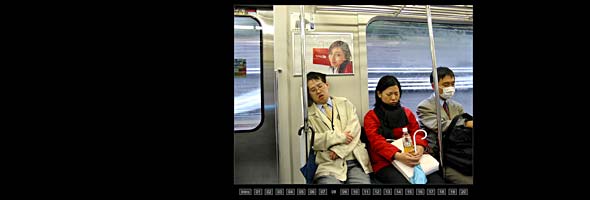
David Crawford | Stop Motion Studies - Tokyo (Series 8-12) | 2003-04
|
 |
David Crawford: Stop Motion Studies - Tokyo (Series 8-12)
From an imaginary world to the real world: David Crawford’s Stop Motion Studies (25) capture the
posture and reactions of the people he encounters on subways. In the series at Turbulence we see Crawford’s impression of traveling on the Tokyo subway. Crawford is influenced by other net artists, specifically Heath Bunting (26), who see the world as populated by many networks. To Bunting the body itself is a network. The Internet is a transportation system, passing on electrical signals, not unlike the nervous system, instead of people like the subway does. The world is however full of related structures and systems which serve our desires and needs.
Crawford has taken hundreds, maybe thousands of pictures, and turned them into little animations. He has edited them down so fiercely that they show nothing but the bare essentials of the moment. This work is striking because of its clarity. The images look crisp and sharp. Clean. It is easy to imagine sound for them. You almost feel the movement of the carriages and hear the monotonous noise of the train because of the edgy editing. It is like you are there, or like you could be. Again the absence of sound is striking, and it enhances our imagination. David Crawford not only documented people on subways: he takes us along with him.
The Stop Motion Studies are an interesting hybrid of photography, film and net art. It looks like a project that could easily fit in a top end gallery or museum. But somehow it would not have the same effect as a film series in a dark room. This work really works best online. On the web it can show its different sides all at once: it is a photo album that has come alive; we can flip through its pages at our own pace. We can let our favorite animation run over and over again, and experience it as if we were right there, sitting where the artist was sitting gently rocked back and forth, or imagining the sound of the station announcer.
It is tempting to compare this work to a project by Heath Bunting that was also created in subway stations in Tokyo: Communication Creates Conflict, from 1995 (27) and to another project by Bunting from a year earlier: the King’s X Phone In (28), in which ‘King’s X’ stands for King’s Cross, a large railway station in London. Both works could be compared to the Stop Motion Studies because of their broad interpretation of net art. Communication Creates Conflict used all kinds of communication systems, from postal system to fax and email, to enable people to send messages to complete strangers. Heath Bunting would stand in the Tokyo subway with a sign carrying a name chosen by the audience/participant and if someone with that particular name approached him, that person would be given their message. The work was about fun, creating confusion, about unexpected meetings and random communication, like many works by Bunting. It connected several networks: mail, internet, fax, subway and human. Kings X Phone In connected internet, the telephone system and the street. People were approached via a website, email and word of mouth to call the public phones on King’s Cross station on Friday 5th August 199 , around 18.00 GMT. The work unexpectedly turned into a big party around the public telephones of King’s Cross, which were ringing all the time. These projects dealt with networks, they dealt with people’s responses to networks, yet they lacked the strong focus on the individual responses that the Stop Motion Studies have, through their mixture of portrait photography, film and net art. Actually Communication Creates Conflict is closer to the Stop Motion Studies because it contains some documented photos of surprised individuals receiving their messages.
The Stop Motion Series also remind me of a work by Masaki Fujihata: fieldworks@alsace from 2002 (29). In this work Fujihata interviewed people crossing the border between Germany and France on camera, and displayed the interviews in a very big, complex installation. Its subtitle is “the record of a journey reconstructed in three dimensional space”. Where Fujihata blows the portraits out of proportion inside a huge, quite overpowering new media installation, thus emphasizing the ordinary EU citizen in an EU funded project, Crawford enhances his portraits by reducing them, bringing their movement and life down to a few animated stills, condensed movies on a web site. He not only creates powerful art this way, but he also empowers rather than overpowers the audience, by leaving them their own space and time, and the power to control the images. The audience in one network (the web) can meet the audience in another (the subway).
|
| ten years of turbulence |
 |
|
 |
  diez años de turbulence diez años de turbulence |
 |
Turbulence offers continuous support to online art, but there are others that do so as well. Its
basis in radio, sound and performance art have given Turbulence an extra quality however, an eye and ear for a very broad scope of works, works that go beyond the web. Does writing a book on someone performing you still have anything to do with the body in online art or performance art? Yes, because it is a reflection of someone’s loss of composure through media and an attempt to regain control through another person. It is an indirect performance, a conceptual art score, much like a musical notation. Performance art is nolonger about unquestionable authenticity and live art alone. Instead it has become art that only needs to appear live and that represents our human identity and our human body in a potential or virtual live activity. Performing is also about questioning performance.
Time flies. It seems like only yesterday that Turbulence was founded. I have only looked at a few works in its database in this text, and there is so much more. There is a wealth of art works here that deserve attention from beyond the net art community. Let’s hope its discovery by a larger audience is just a matter of time.
Josephine Bosma.
Josephine Bosma (1962) is a writer and critic. She started working in the field of new media art making radio shows, documentaries and interviews about the topic for VPRO and Patapoe radio in 1993. She has published interviews, reviews and texts about art and new media in various books and magazine, both on and offline, since 1996. Her work mostly focusses on net art, sound art and net culture. Josephine Bosma has also organized several events, like the radio section of the tactical media festival Next5Minutes 2 (1996) and 3 (1999), an evening about net art criticism (2001) and the newsletter CREAM (2001/2002). She lives and works in Amsterdam.
http://houseoflaudanum.com/bosma
|
 |
NOTES:
|
 |
     |
 |
 |
|
|